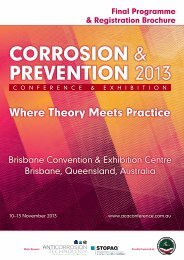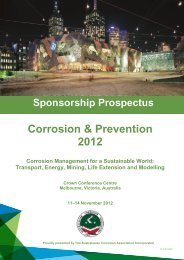Blast Cleaning Standards: Cutting through the ... - aca conference
Blast Cleaning Standards: Cutting through the ... - aca conference
Blast Cleaning Standards: Cutting through the ... - aca conference
- No tags were found...
You also want an ePaper? Increase the reach of your titles
YUMPU automatically turns print PDFs into web optimized ePapers that Google loves.
Inhomogeneity of organic coatings and its effect of protection<br />
Sina S. Jamali 1 , Douglas J. Mills 2<br />
1 Intelligent Polymer Research Institute, AIIM Facility, Innovation Campus, University<br />
of Wollongong, NSW Australia 2522<br />
2 School of Science and Technology, University of Northampton, St George’s Avenue<br />
Northampton, NN2 6JD, UK<br />
Presenter email address: Sina.Jamali198@uowmail.edu.au<br />
Summary<br />
An important aspect of polymeric coatings from <strong>the</strong> protection point of view is <strong>the</strong>ir<br />
inhomogeneous nature. Phenomena such as lack of cross-linking, inappropriate pigmentation,<br />
quick solvent evaporation etc may introduce local micro defects. The diffusion rate at <strong>the</strong>se<br />
micro defects is proportional to <strong>the</strong> ionic concentration of <strong>the</strong> solution at which <strong>the</strong> coating is<br />
immersed and <strong>the</strong>refore <strong>the</strong>y have been known as “D” or direct type areas. On <strong>the</strong> o<strong>the</strong>r hand<br />
is <strong>the</strong> highly resistive “I” type area where <strong>the</strong> ionic resistance increases with increasing <strong>the</strong><br />
ionic concentration of environment. It has been revealed that corrosion proceeds <strong>through</strong> <strong>the</strong><br />
ionic conduction pathways within <strong>the</strong> coating layer when <strong>the</strong> metal is protected by an organic<br />
coating. Traditionally it is believed that a certain level of adhesion is a fundamental<br />
requirement to avoid anodic and cathodic areas connecting underneath <strong>the</strong> coating. Therefore<br />
<strong>the</strong> ionic resistance and specifically D type areas play an important role to determine <strong>the</strong> anticorrosive<br />
properties of paint.<br />
In <strong>the</strong> present study a set of organic coatings in <strong>the</strong> form of detached coatings has been<br />
examined using DC technique to determine <strong>the</strong> D/I type ratio. The significance of thickness<br />
and curing condition on D area formation has been also investigated. Consequently coatings<br />
were applied on steel panel and <strong>the</strong> corrosion behaviour was looked at in <strong>the</strong> long term. Also<br />
<strong>the</strong> adhesion strength of coatings was examined by pull-off method. Results indicate that <strong>the</strong><br />
protection efficiency of coating is mainly governed by D/I type ratio but is relatively<br />
insensitive to <strong>the</strong> adhesion strength. A <strong>the</strong>ory of how <strong>the</strong> permselectivity of coating<br />
influences <strong>the</strong> protectiveness will be advanced.










